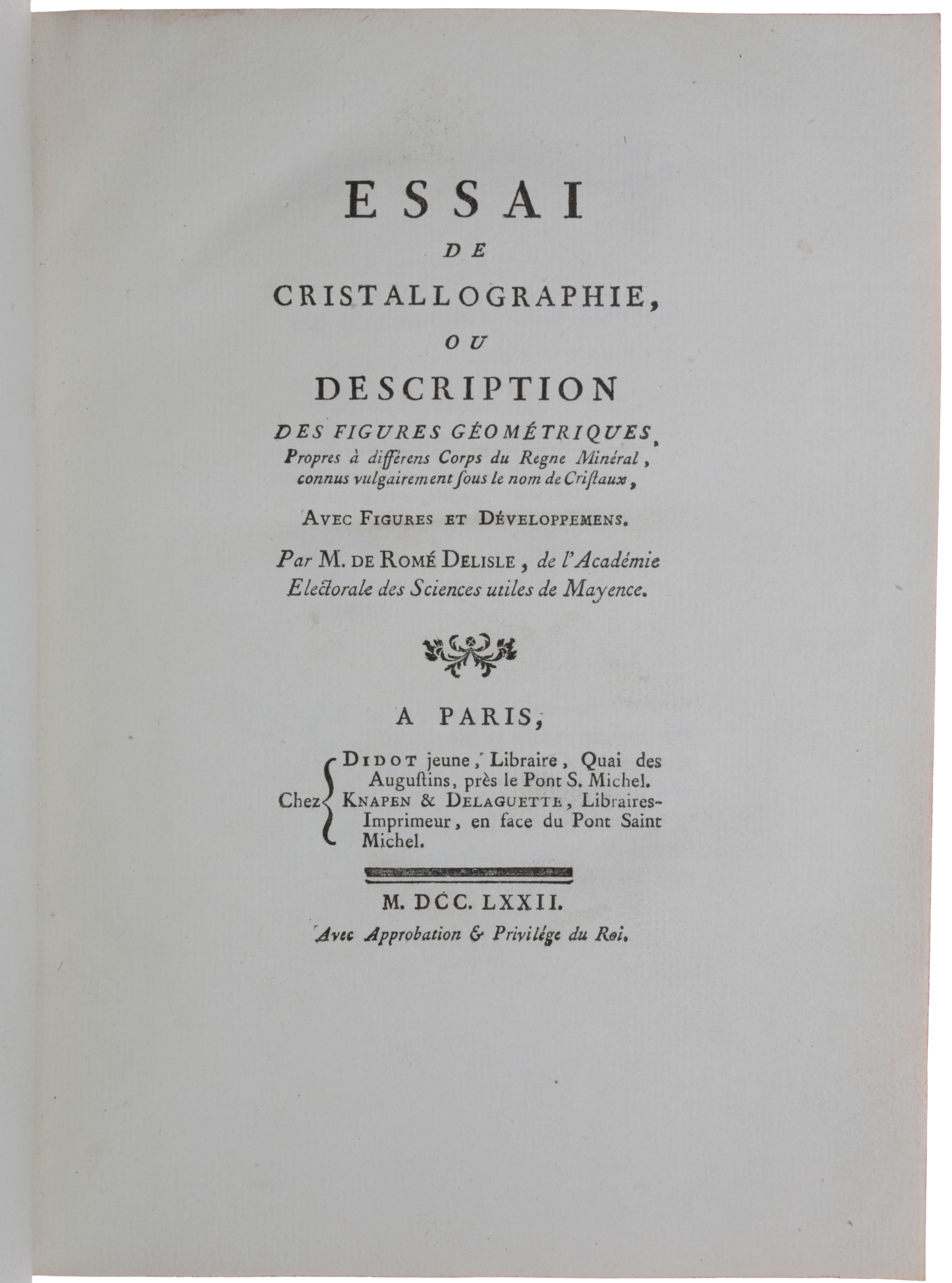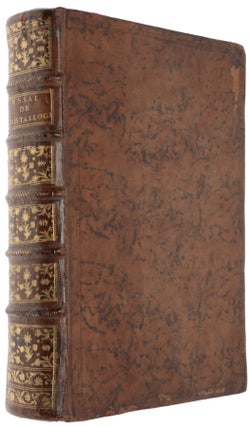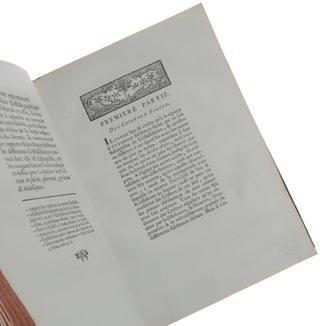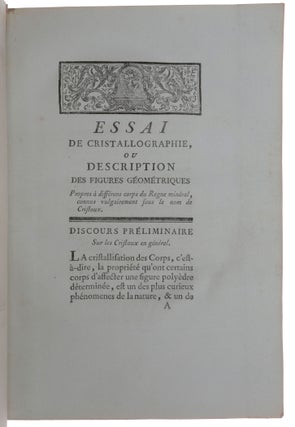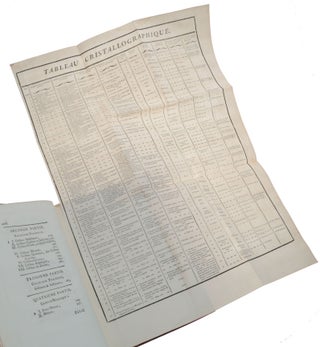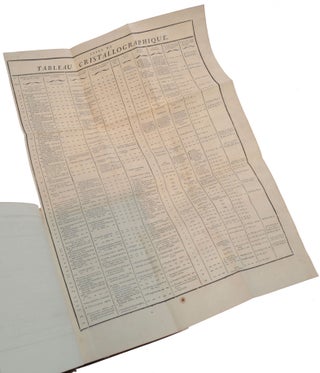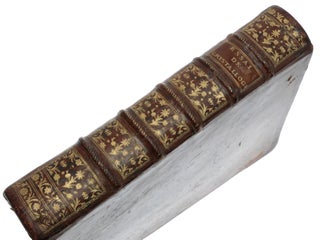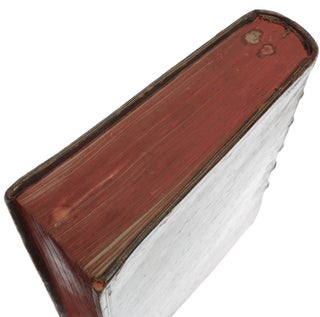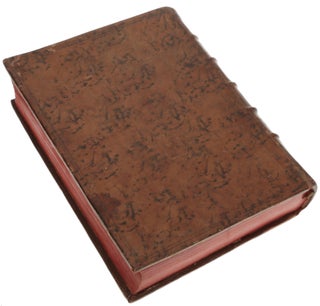Essai de Cristallographie, ou Description des Figures géométriques, propres à différens Corps du Regne minéral, connus vulgairement sous le nom de cristaux, avec figures et développements.
Paris: Didot jeune and Knapen & Delaguette, 1772. First edition, a magnificent and very rare large paper copy (both larger and printed on thicker paper than the octavo issue), of one of the fundamental works of modern crystallography; it appeared 12 years before Haüy’s Essai d’une Théorie sur la Structure des Cristaux. Romé de L’Isle established that various shapes of crystals of the same natural or artificial substance are all closely related to each other. Measurements he took with a goniometer enabled him to determine that the angles between corresponding faces of a crystal are always the same, which earlier had only been described in specific cases, in particular by Niels Steno (this is often described as the first law of crystallography). In addition, he demonstrated that these angles are a characteristic of mineral type, introduced the concept of truncation, and also enlarged the crystallographic vocabulary. He “identified 110 crystal forms (drawing upon Linnaeus, who had listed forty) and described in minute detail the minerals that exhibited them. He subdivided the various substances into salts, stones, pyrites, and metallic minerals, stating that he agreed with Linnaeus that geometrical form is the chief characteristic by which minerals may be classified. Also like Linnaeus, he held that saline principles imprinted their own geometrical form upon the earthy constituent of each mineral” (DSB). “Very scarce. The Cristallographie ranks as one of the great contributions to the science of crystals. In it Romé de L’Isle attempted to make a comprehensive classification of crystals. By the time he wrote his volume he was extremely familiar with the subject and this work greatly surpassed all previous works in scope and detail. To apply his classification, he adopted a morphological approach in which he attempted to relate the diverse forms of crystals of the same substance. As a general morphological concept he introduced the idea of the ‘primitive form’. All crystals of the same inorganic substance, no matter how different in appearance, had a fundamental and common geometrical form – the primitive form – to which their actual crystal shapes related … In this first edition of the Cristallographie, Romé de L’Isle identifies 110 crystal forms by which minerals crystallize. Grouped under each of these shapes are describe the minerals that exhibit similar habits, including the approximate angles between crystal faces. These forms were all derived from a common saline ingredient in every mineral that worked at a molecular level” (Schuh). Pages xii-xxviii contain an annotated bibliography of the principal works on crystals. The only large paper copy listed by ABPC/RBH is the Norman-Freilich copy, but our copy is significantly larger than even that copy (265 x 205mm versus 249 x 193mm). “Romé, the son of a lieutenant in the cavalry, studied humanities at the Collège Ste. Barbe in Paris. In 1756 he entered the Royal Corps of Artillery and Engineering, which he accompanied, as a secretary, to the French Indies in the following year. From 1758 until 1761 he was in the enclave of Pondicherry, French India. When it fell to the English in 1761, Romé was taken prisoner and transported to China, where he stayed until 1764, when he returned to France” (DSB). “Romé de L’Isle had started collecting minerals during his travels as a naval officer. Back in Paris after the Indian Wars, he was introduced into mineralogy by the apothecary, chemist and mineralogist Balthazar Georges Sage (1740-1824), who became his friend. It was very fashionable at the time in Paris to have a mineral collection. The owner of an important private collection, Pedro Francisco Davila, wanted to sell his. At Sage’s suggestion, he asked Romé de L’Isle to draw up the inventory. Romé made a very thorough job of it, the inventory running up to three thick volumes. This was his first work on mineralogy, published in 1767 [Catalogue systématique et raisonné des curiosités de la nature et de 1’art qui composent le cabinet de M. Davila]. It gave him the opportunity to study crystalline forms in detail and led to his Essai de Cristallographie (1772) … “The context of the time was not very favourable for such studies, for had not the famous French naturalist Buffon written in his Natural history of Minerals, volume 1 (1783): ‘One has pretended that rhombohedra constitute a specific character of calcareous spar, without being attention to the fact that some vitreous or metallic substances also crystallize in rhombohedra and that if calcareous spar does crystallize often in rhombohedra, it also takes different other forms; and our crystallographers, when trying to borrow from geometricians the way to transform a rhombohedron into an octahedron, a pyramid or a lens, have done nothing more than substitute ideal combinations to the real facts of Nature. This crystallization in rhombohedra, like all others, will never have a specific character. Not only is there no crystalline form common to different substances, but, conversely, there are few substances which do not present different crystallization forms, as shown by the prodigious variety of forms of calcareous spar itself’ … “In the preface Romé noted that ‘of the curious phenomena of the mineral kingdom, those which struck him most were the regular and constant forms taken by some bodies designated by the name of crystals.’ He was encouraged by the works of Linnaeus, he added, to undertake the study of the angular forms of crystals and of their transformations. Their polyhedral shape was only known from the Ancients only for quartz, diamond and a few others, and Romé widely extended this observation. Minerals were divided by him into four classes: salts, stony, pyritic, and metallic. For each mineral, the most frequent forms observed are described, with a reference to Linnaeus’s classification in Systema naturae … Steno’s ideas relative to the growth of quartz layer by layer are quoted at length, and Romé de L’Isle felt that they could be applied to all crystals. The book was a success, acclaimed by Linnaeus himself, and brought international fame to Romé de L’Isle … The importance of Romé de L’Isle’s work was stressed by Haüy who wrote (Leçons de Physique, 1795): ‘To the exact descriptions he gave of the crystalline forms, he added the measure of the angles, and, which was essential, showed that these angles were constant for each variety. In one word, his crystallography was the fruit of an immense work, almost entirely new and most precious for its usefulness.’ “Romé de L’Isle was also the first mineralogist to give a rational description of twins … He described, for instance, the dovetail twin of gypsum and the feldspars twins. He introduced the term macle to designate a crystal in which ‘one half is produced by the inversion in the opposite sense of the other half of the same crystal’ – a property which he demonstrated by the concordance of angles” (Authier, pp. 313-6). “Romé’s friendship with Sage brought him membership in a number of learned societies, including the academies of Mainz, Stockholm, Berlin, and St. Petersburg. But it did him no service with the Paris Académie des Sciences, which rejected him on the ostensible grounds that he was a mere ‘catalogue maker.’ It is likely that Romé’s controversies with Buffon also played a part in his rebuff by the Academy” (DSB). Freilich sale 460; Hoover 2681; Norman 1847; Schuh, Mineralogy & Crystallography: A Bibliography, 1469 to 1920, 4151; Ward & Carozzi 1906; Wellcome IV, p. 553. Authier, Early Days of X-ray Crystallography, 2013.
4to (265 x 205 mm), pp. [v], viii-xxxii, 427, [3] (including half-title), with 2 folding letterpress tables and 10 folding engraved plates. Contemporary calf, spine gilt in compartments with red morocco lettering-piece, red edges.
Item #5371
Price: $9,500.00

